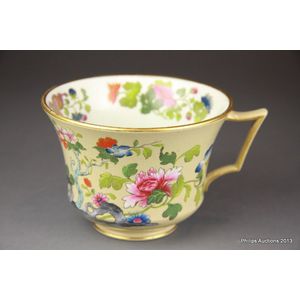Ridgway Salt Cellar with Grape Vine Gilding and Landscape Decoration
You must be a subscriber, and be logged in to view price and dealer details.
Subscribe Now to view actual auction price for this item
When you subscribe, you have the option of setting the currency in which to display prices to $Au, $US, $NZ or Stg.
- Gilding - Gilding is a method of ornamentation whereby a thin sheet of gold metal is applied to items made of wood, leather, ceramics, glass and silver for decorative purposes.
For furniture including mirrors, the sheet of gold is usually applied over a coating of gesso. Gesso is a mixture of plaster of Paris and gypsum mixed with water and then applied to the carved wooden frames of mirrors and picture frames as a base for applying the gold leaf. After numerous coats of gesso have been applied, allowed to dry and then sanded a coat of "bole", a usually red coloured mixture of clay and glue is brushed on and allowed to dry, after which the gold leaf is applied. Over time parts of the gilding will rub off so the base colour can be seen. In water gilding, this was generally a blue colour, while in oil gilding, the under layer was often yellow. In Victorian times, gilders frequently used red as a pigment beneath the gold leaf.
Metal was often gilded by a process known as fire gilding. Gold mixed with mercury was applied and heated, causing the mercury to evaporate, the long-term effect of which was to kill or disable the craftsman or woman from mercury poisoning. The pursuit of beauty has claimed many victims, not the least of which were the artists who made those pieces so highly sought after today. - Circa - A Latin term meaning 'about', often used in the antique trade to give an approximate date for the piece, usually considered to be five years on either side of the circa year. Thus, circa 1900 means the piece was made about 1900, probably between 1895 and 1905. The expression is sometimes abbreviated to c.1900.
This item has been included into following indexes:
Visually similar items

A Royal Worcester bowl. 1922, the scallop edged bowl with a full blown rose motif inside and out upon a blush ground and embellished with shot gold colours; puce backstamp underside. Height 7 cm. Diameter 18 cm.

A Wedgwood Drabware large breakfast cup, circa 1810, of waisted London shape with a 'French' square handle, the exterior with 'Famille rose'-style decoration with a bird in a flowering shrub and other flowering plants on the mushroom ground, the white-glaz

A Japanese Imari bowl, Meiji Period, 1868-1912, decorated inside and out in enamels and gilt, 12.9 cm high, 27.5 cm diameter

Israeli silver cup H6 cm approx, 59grams approx
